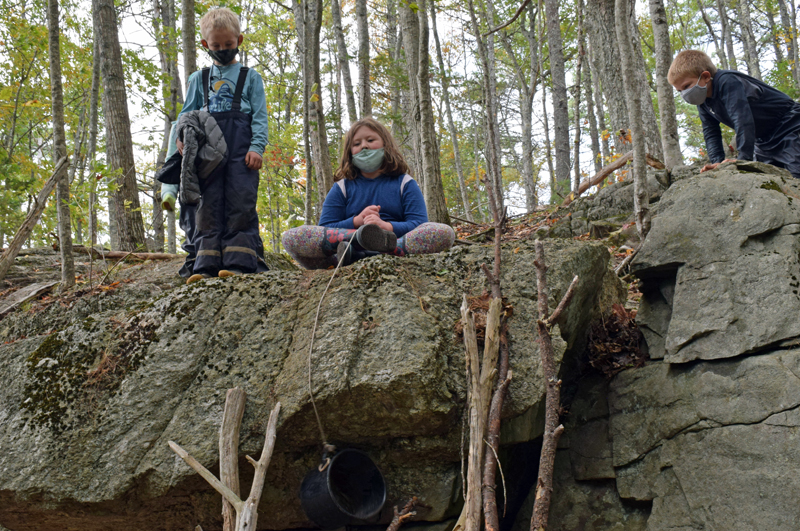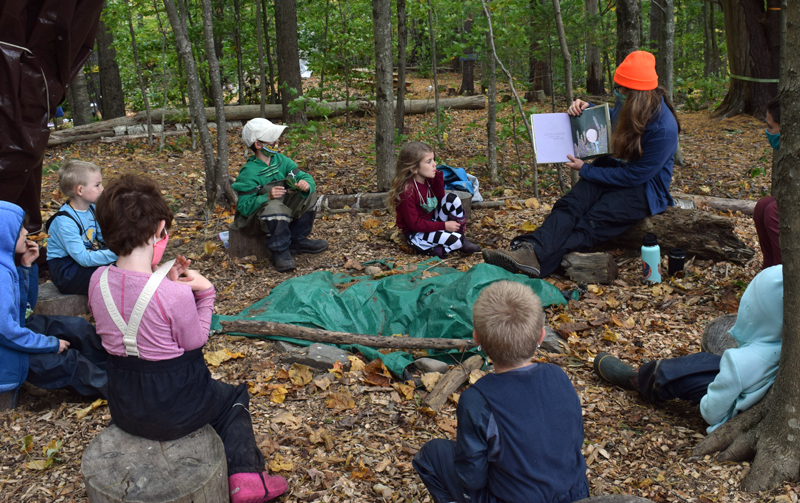
Students “mine” for quartz during playtime at Juniper Hill School for Place-Based Education in Alna on Oct. 1. The school has shifted to 100% outdoor learning for the 2020-2021 school year. (Evan Houk photo)
Not much has changed for the Juniper Hill School for Place-Based Education in Alna now that students have returned to in-person instruction for the year.
Among the small shifts to facilitate learning in the age of COVID-19, students now spend all of their time outdoors, instead of just the majority of their time, and must remember to wear face coverings and keep their distance from one another.
The school previously had a 60-40 split between outdoor and indoor learning, according to Robin Huntley, elementary director and teacher at the school.
This aligns the school even more closely with the place-based values that form the core of its philosophy. Juniper Hill was already working to incorporate more outdoor instruction before COVID-19, Huntley said.

Henry Kahrl, 7, a student at Juniper Hill School for Place-Based Education in Alna, pretends to be a cat during playtime Oct. 1. (Evan Houk photo)
Juniper Hill’s website quotes David Sobel, Antioch University professor and author of “Place-Based Education: Connecting Classrooms and Communities,” on his definition of the term.
According to Sobel, place-based education “is the process of using the local community and environment as a starting point to teach concepts in reading and other language arts, mathematics, social studies, science, the arts and other subjects across the curriculum.”
Students now only go inside a yurt classroom a few at a time to use the bathroom or retrieve learning materials. A new hand-washing station is set up in the outdoor learning area.
At a volunteer work day Oct. 3, Juniper Hill dads continued work on an outdoor hut that will serve as a classroom and a dry storage area for learning materials.
The workers placed a tarp around the outside of the hut Oct. 3. The structure is made entirely from tree branches and sticks collected from the woods. The tarp will help keep the elements out. The hut will also be heated with a wood stove.

Robin Huntley, teacher and elementary education director at Juniper Hill School for Place-Based Education in Alna, teaches a math class outdoors Oct. 1. (Evan Houk photo)
Other parents and children helped to spread mulch along the school’s trails and worked on other projects around the campus.
The school has an early childhood program for prekindergarten- and kindergarten-age students and an elementary program for students in grades one through five. Both groups attend from 8:30 a.m. to 3 p.m. four days a week and 8:30 a.m. to 1 p.m. on Fridays.
Students in the early childhood program stay in a separate area of the 42-acre riverfront property called the “Salamander Woods.”
Adrienne Hoffman, a teacher and the early childhood director, said it is “business as usual” for the little kids.
The biggest change was to move the tree stumps the students sit on farther apart, said Gabrielle Roxon-Erskine, an early childhood supporting teacher.

A hand-washing station is a new addition at Juniper Hill School for Place-Based Education this school year. (Evan Houk photo)
The school is already relatively small, working to keep a ratio of one teacher for every four to five students, which makes physical distancing less challenging. The school currently has 25 students.
The students use a technique called “wings” to stretch out their arms and see if they are too close to one another.
However, some students find it hard to remember to distance since they are already in one another’s “bubbles,” as they play together outside school.
River Brazwell, 9, said he and his sister were able to ride their bikes to a friend’s house to play during the distance learning period at the end of last school year.
When COVID-19 arrived in Lincoln County in mid-March, the school closed, then shifted to distance learning for the remainder of the school year, following recommendations from the Maine Department of Education.
Huntley said this required teachers to draw up packets and lesson plans to send home to students and to meet with them remotely throughout the week. Most of the learning required strong engagement by the parents.

Students in the early childhood program at Juniper Hill School for Place-Based Education preserve leaves in wax on Oct. 1. (Evan Houk photo)
Huntley said distance learning turned out to be surprisingly beneficial for most of the students, because they were able to spend more time with their families and have time to themselves to do schoolwork on their own terms.
She said students were on a screen with a teacher for just one hour each day as a group and 30 minutes individually each week, to keep the students’ days playful and nature-based.
“It’s amazing to see how much the kids have grown,” Huntley said.
On Thursday, Oct. 1, the elementary students were engaging in one of the play times that are spread throughout the day.
“In total, there’s about an hour of play during the day, outside of lessons,” Huntley said of the elementary students.
One group of kids was “mining” for quartz, they explained, to use as currency for “Fort Eagle,” a fort they built deeper in the woods.
The kids were playing on a rock ledge, where Huntley was watching closely to ensure they kept their distance, kept their face coverings on, and did not fall off the ledge or smash their fingers.

Early childhood students at Juniper Hill School for Place-Based Education climb on a slide in the “Salamander Woods.” (Evan Houk photo)
“They have to ask before they take risks, like climbing on the ledge,” Huntley said.
Another rule at Juniper Hill is that any situation a student gets themselves into, they have to get themselves out of, in an effort to teach independence and self-reliance.
For example, if a student climbs a tree — a common occurrence at the school — they have to find their own way down, albeit with faculty supervision.
During playtime, a few other students made what they called a “hanging steering wheel” that consisted of a rope with an odd-shaped piece of wood attached to it, hung from a tree branch.
The various playtimes at Juniper Hill are free-form and imaginative. The students use whatever they find in the woods and make up their own games around those objects.
The school has a “mud kitchen” and a rain barrel, as well as climbing bars, hammocks, and swings for kids to play on in the woods.
For the elementary students, the afternoon is reserved entirely for math and reading, while the morning includes playtime and place-based education that incorporates science and social studies.

Lilly Lee, 9, a student at Juniper Hill School for Place-Based Education, places her hand on her heart, instead of raising her hand, to be called on to speak. The school employs the gesture to encourage children to speak from the heart. (Evan Houk photo)
Students sit in a circle on tree stumps. There are chalkboards set up in the outdoor classroom spaces and each elementary student has a clear, lockable plastic container to keep their learning materials safe from the elements. Each student also has a “Rite in the Rain” waterproof notebook.
The students are glad to be back at school with their friends and to be outdoors all the time.
“It’s mostly outside and they give you more time to learn, they don’t just rush you,” said John Williams, 7, who is beginning his first year at Juniper Hill after transferring from a public school.
Of whether they would still like learning outdoors in the cold winter, a few students said, “Yes, because we have gear!”
They were referring to the winter gear they bundle up in for cold temperatures. Each student must have certain gear to wear in all types of weather.
The only type of weather the school considers hazardous is extreme weather, like lightning and high winds.
Due to Department of Education guidelines, the school had to close Sept. 30, after a severe windstorm that morning knocked out power — although electricity isn’t necessarily essential to the students’ learning experience.
“It was so much fun,” Aura Jones, 10, said of the playtime before they had to be sent home that day. “We were on the trees and it felt like we were actually moving on the sea.”

Teacher Maggie Smith reads a book to students at Juniper Hill School for Place-Based Education on Oct. 1. (Evan Houk photo)
Spreading the word
Ann Stires, who founded Juniper Hill 10 years ago and is the school’s director of development, outreach, and advocacy, said consulting for public and private schools has taken off since COVID-19 arrived.
Juniper Hill has hosted an observation program at the school for five years.
At the same time the school began to expand its offerings to include an outreach program and a professional development program, requests grew by about 40% as schools started making plans to return to in-person learning during the COVID-19 pandemic.
Since Sept. 1, Stires said, she has worked with 11 different schools and two full school districts on integrating more outdoor learning into their curriculum.
Locally, Stires held a workshop titled “Stepping Outside the School Building With Students for the First Time” at Edgecomb Eddy School.
She said that after working with Georgetown Central School, it shifted to 90% outdoor learning for prekindergarten through second grade students. She said the school is working toward shifting grades three to six outdoors as well.
Stires said those two schools, both in AOS 98, hope to continue the shift to more outdoor learning even after the pandemic. She said she is booking a lot of workshops focused on teaching outdoors in the winter.
Stires cited an article in the journal Frontiers in Psychology that reviews numerous studies of whether experiences with nature promote learning.
“Hundreds of studies now bear on this question, and converging evidence strongly suggests that experiences of nature boost academic learning, personal development, and environmental stewardship,” the preamble to the academic review states.
School teachers and administrators are beginning to take notice of the benefits.
Stires has consulted with hundreds of schools across the country, from early childhood to higher education, since beginning a consulting program, and is encouraged by the growth of nature-based schools across the country.
Stires said that 10 years ago, there were only 24 nature-based schools in the U.S. Today, there are over 500.






